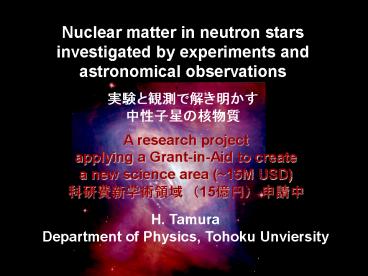Nuclear matter in neutron stars - PowerPoint PPT Presentation
Title: Nuclear matter in neutron stars
1
Nuclear matter in neutron stars investigated by
experiments and astronomical observations ???????
????????????
A research project applying a Grant-in-Aid to
create a new science area (15M USD) ????????
(15??) ???
H. Tamura Department of Physics, Tohoku Unviersity
2
1. Motivation
3
World of matter made of u, d, s quarks
Stable
Higher density
How well can we understand neutron stars from
strangeness nuclear physics?
3-dimensional nuclear chart
by M. Kaneta inspired by HYP06 conference poster
4
Maximum mass of n stars and hyperon mixing
(1.97??0.04)M?,
(1.97??0.04)
NNNNN
NNNNN
NNNNN YN YY
NNNNN YN YY
central density
Radius
Z.H. Li and H.-J. Schulze, PRC78(2008) 028801
n-star mass seems to be explained by hyperon
mixing.(but slightly too light)
1.44M
5
Heavy neutron star?
Shapiro delay
Heavy neutron star?
- Nature 467 (2010) 1081
- J1614-2230
- (1.97??0.04)Msun
To obtain robust error estimates, we used a
Markov chain Monte Carlo (MCMC) approach to
explore the post-fit ? space and derive posterior
probability distributions for all timing model
parameters
6
Hyperon mixing in neutron stars
Hyperon (and kaon) fractions are sensitive
to hyperon (kaon) potentials (YN, YY, KbarN
interactions)
USlt0 U?lt0
We need XN force (both I 1 and 0), LL
force SN force (I 3/2 (S-n) is particularly
important) KbarN force (both I1 and 0)
LN-SN and LNN force, LN p-wave force,
USgt0 U?lt0
Fraction
USgt0 U?gt0
????
r/r0
7
EOS constraints from astronomical observations
Thermonuclear Burst in X-ray Binaries 4U
1608-248 EXO 1745-248 4U 1820-30
Probability of EOS P(e)
Ozel et al., arXiv 1002.3153 astro-ph.HE
A. W. Steiner, et al., arXiv1005.0811
Better understanding of nuclear matter in nuclear
physics More and reliable data for radius from X
ray observations
gt EOS can be determined.
8
2. Our Project
9
r
EOS coveringwide range of r, p/n asymmetry,
strangeness
World-best two acceleratorsandastronomical
satellite
D theory
neutron star
C astronomical X-ray observation
?radius and mass
? asymmetric nuclear matter and thin
neutron matter
A strangeness nuclear physics
? Interactions between strange particles
10
Neutron star matter and our research subjects
Ohnishi (YITP)
fm-3
Takahashi (KEK)
Tamura (Tohoku)
Murakami (Kyoto)
n, p, L, X,.. ?
n
nuclei n
Nakamura (TIT)
Baryon density
Fraction
Takahashi (JAXA)
11
????
- X00 ??????????????????? ?? ??(???)
- Nuclear matter in neutron stars investigated
by H. Tamura (Tohoku) - experiments and astronomical observations
- A01 ????????????????? ?? ??(???)
- Strangeness in neutron-rich nuclear matter
H. Tamura (Tohoku) - A02 ???????????????????
????(KEK) - Multi-strangeness baron-baryon
interactions T. Takahashi (KEK) - B01 ???????????????
????(???) - Properties of low/medium density
neutron-rich T. Nakamura (TIT) - nuclear matter
- B02 ????????????????? ????(??)
- EOS of high-density neutron-rich nuclear
matter T. Murakami (Kyoto)
12
A01 Strangeness in neutron-rich matter Sp,
S-p scattering exp. Miwa, -gt SN
interactions(in particular, Sp S-n
interaction) Spectroscopy of n-rich L
hypernuclei (E10) Sakaguchi,... g-spectroscopy
of hypernuclei (E13) Tamura, Koike,.. -gt LN,
LN-SN (LNN) interaction in n-rich matterK-
nuclear bound states (E15) Outa, Iwasaki,.. -gt
KbarN interactionA02 Multi-strangeness
baryon-baryon interactions X hypernuclear
spectroscopy (E05) Nagae, X atomic X-rays
(E03) Tanida, LL hypernuclei and X atomic
X-rays (E07) Nakazawa, S -2 resonance
Sato, Imai,... -gt LL, XN, XN-SN
interactions, H dibaryon-like state
A Strange nuclear matter
at J-PARC
Tamura (Tohoku)
??????
T. Takahashi (KEK)
13
B EOS of neutron-rich matter
at RIBF
Nakamura (TIT)
Murakami (Kyoto)
Horikoshi (Tokyo)
14
C X-ray observations
T. Takahashi (JAXA)
- Observables for radius
- kHz QPO (quasi periodic oscillation)
- Periodic X ray burst from a nuclear fusion
spot orbiting near the surface of the n star
Several data samples exist.
- Red shift (30) of absorption lines from the
surface of the n star
Only a few data samples exist.
- ASTRO-H 2014
- 10 good samples of kHz QPO and red shift
for radius expected. - Better X-ray detectors should be developed for
future
15
Present constraints to mass-radius relation
16
D01 Theory group (slide by Ohnishi)
???????? ?? ?(?????)????????????? ?????
????(???)??????????????? ?? ?(?????)???????????
?? ?(???)n-rich ???????? ?? ?(???) ???????? ?
??(??) ?????????????? ?? ?(???)
????????????????? ????(KEK) K????????????? ????(?
?) ????????????? ????? ??(??)???(???)???(?????)?
??(?)(JAEA)????(?????)???(???)???(???)
17
D01 Theory group (slide by Ohnishi)
- ???????????????(?????????(??(?)??)?...)
- ???????????????????? Abe, Seki, 2009
- ???????????????BEC-BCS cross over
- ????????????????????
- ????????????? (?????????...)
- r0 ???????????0? ????????????????
- ?????????(M3Y)????HF
- GMR?????????????????
- ?????????(????????????...)
- ?????-????? ? ???S???(Hypernuclear Sym. E. ?)
- ???????????(K, p, ..)
- M1.67 Msun ????3??
- ??????(????????????...)
- ?????????( p ??)????
- ????????????? ? Quarkyonic??????????
- X??????????????? (???????????...)
- TOV????????M(R) versus P(e) ?1?1??
- ?????????? ???????( Baym et al., Lattimer et
al.) - ???????????????????????????????!(????)
- ??????(?????????....)
- ???????????????????????
18
How to use money shared use
A01 Detector system for YN scattering exp.
(fiber trackers) Development of
high-rate beam line trackers Fast
readout system for Hyperball-J A02 Emulsion,
emulsion scanning system DSSD for LL
nuclei and X X-rays Decay particle
detector (TPC) for S-2 resonance
B01 A new generation neutron counters gt A01
kaonic nucleus, g-ray calorimeter
(LaBr crystal array etc.) gt A01 hypernuclear g
rays Laser cooling system for cold
atoms B02 TPC in SAMURAI CsI forward
calorimeter C01 Development of new X/g-ray
detectors (Compton camera w/ Ge, CdTe,
Si..) gt can be tested in
J-PARC/RIBF D01 PDs Workshops
NEBULA (NEutron Detection System for Breakup of
Unstable Nuclei with Large Acceptance)
SAMURAI
RIBF SAMURAI n-coutners, g detectors, TPC
19
3. Summary
- Combined with nuclear physics experiments and
astronomical observations, nuclear matter EOS in
neutron stars will be able to be determined.
- The proposed project combines researches on
A Strangeness nuclear physics experiments at
J-PARC B Neutron-rich nuclear experiments
at RIBF Ultra-cold Fermi atoms by
laser cooling C X-ray observations by
ASTRO-H satellite D Theoretical studies
in order to determine THE EOS covering wide
ranges of density, asymmetry, and including
strangeness.
- We are applying a grant (15M USD for 5 years in
total) to MEXT.































